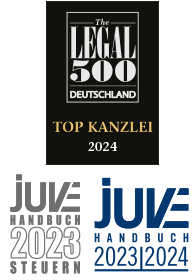The Goldfinger Model - a Case of Tax Evasion?
According to press releases published between 2009 and 2015, the state lost tax revenue of more than one billion euros as a result of the so-called "Goldfinger" model. The name "Goldfinger - which is based on the James Bond movie of the same name - was commonly used for this tax saving scheme because, in the context of this model, the participants bought and sold a large quantity of gold. Although courts of law have confirmed that, in principle, the Goldfinger model is compatible with tax legislation, the department of prosecution and the tax investigation department consider this a case of systematic and large-scale tax evasion in connection with tax saving schemes.
The tax framework conditions of the Goldfinger model
The "Goldfinger" model was operated both as an exclusively national and as an international scheme. In the framework of a purely national design, the model had the effect of a tax deferral. The international design of this scheme typically led to a final reduction of the income tax burden.
Under both models, private companies are established by the taxpayer or his/her (tax) adviser either in Germany or abroad depending on the specific model selected. This commercial private company bought and sold physical gold. Because the profit of this company could be established using the net income model and the gold was correctly classified as part of the current assets, the costs of acquisition led to immediately deductible operating expenses (section 4 sub-section 3 sentence 4 alt. 3 EStG [Income Tax Act]). In this respect, corresponding losses from commercial losses were incurred in the case of the national structure, while corresponding negative progression revenue was generated in the case of the international structure.
The Goldfinger model in Germany
In the case of the "Goldfinger" model which was exclusively implemented in Germany, the taxpayer set up a private company in Germany. This company bought gold and was then able to assert the costs of acquisition spent on this as immediately deductible operating expenses as a commercial loss. In this process, the company determines its profit according to art. 4 section 3 EStG [German Income Tax] and was not required to keep accounts. This was because the acquired gold could not be classified as part of the fixed assets and gold does not constitute securities (securitisation of a physical asset) or anything comparable with such.
Even though the company does operate in the field of its asset management, its commercial operations (acquisition and sale of gold) were a characteristic of the company. A commercial private partnership (within the meaning of art. 15 section 3 no. 2 EStG) can have working assets, which was subsequently confirmed by the German Federal Fiscal Court (BFH ruling of 19/1/2017, IV R 10/14).
Moreover, this did not constitute a case of tax avoidance pursuant to art. 42 AO [German Fiscal Code] (so-called "abuse of tax planning schemes"). However, the simple exercising of rights cannot constitute such circumvention. In principle, the taxpayer is free to choose a legal structure for the company provided he/she considers the legal tax consequences established by law in accordance with the company structure selected. This was done here.
The losses which were caused by the purchase of the gold reduced the shareholders' positive income. By setting up a commercial company, the application of art. 23 section 1 no. 2 and section 3 EStG was avoided. Therefore, the costs of acquisition of the gold would only have had a taxation effect at the time of the inflow of the sales price. As a result, the tax burden could be deferred through the application of the provision regarding the calculation of profits according to art. 4 section 3 EStG since high losses were incurred shortly before the end of the year by acquiring current assets (acquisition of gold).
The Goldfinger model abroad
The taxpayer established a partnership abroad in accordance with the laws of said foreign country. This company pursued the object of buying and selling or trading in previous metals or other transactions in such. To this end, the company should have a management, offices with computers, internet access, a fax machine and its own e-mail address abroad. The company then pursued its object, i.e. it bought and sold gold. In this respect there was a commercial activity rather than mere property management.
Because of the respective relevant double taxation agreement, profits and losses from the company's commercial operation were only taxable by the state in which the business was carried out (location of business establishment). The provision in art. 32b EStG then established the required domestic nexus. According to this, commercial profits or losses generated abroad can be considered in determining the amount of the tax rate in Germany (art. 32b section 1 sentence 1 no. 3 EStG). The profits are calculated according to national law in order to determine the amount of the progression proviso in Germany (art. 32b EStG). If the foreign losses have a corresponding amount, the tax rate applicable to taxable income in Germany might decline to as little as zero.
In the framework of the Goldfinger model, the foreign income to be considered in the framework of progression calculation can be determined using the net income method since there was no statutory obligation to keep accounts. In this context, the costs of acquisition of the gold could be considered as operating expenses immediately (see above). Trading in precious metals was consciously not included in the scope of application of art. 4 section 3 sentence 4 versions 1 and 3 EStG which provides for expenses only to be considered as operating expenses at the time of the accrual of the sales profit or, in the case of withdrawal, at the time of withdrawal. According to this, the costs of acquisition for the gold could be reported as foreign losses in the tax return. As a result, the tax burden lowered during the year of acquisition since the total income could be reduced to zero via the negative "progression proviso".
As a second step, the gold from the current assets was sold and, usually, profits were generated. Because of the double taxation agreement, this income was exempt from taxes and was only subject to the "progression proviso" in Germany. Therefore, the foreign profits only had an impact in the framework of the growing tax rates as a result of this ("positive progression proviso"). However, since in almost all cases, the users of the "Goldfinger" model were already at the maximum tax rate, i.e. in the highest progression level, the positive progression proviso did not have any further tax-increasing effect.
Federal Fiscal Court rulings regarding the Goldfinger model
The Federal Fiscal Court accepted the national structure (Federal Fiscal Court reference number: IV R 10/14), as well as the international structure (Federal Fiscal Court reference number: IV R 50/14) of the "Goldfinger" model as concepts compatible with tax legislation (see above). In the cases on which these rulings are based, the companies had rented offices, which were e.g. equipped with a computer, internet connection, a fax machine and a telephone. As a result, they constituted business premises within the meaning of the respective DTA without doubt (cf. art 5 DBA-MA). Moreover, the transactions were exclusively operated from abroad so that there was no domestic business establishment.
Legislator's response to the Goldfinger model
The legislator has responded to this and established legal provisions as a result of which the "Goldfinger" model is today considered as being unlawful. With regard to national cases, section 3a was added to art. 15b EStG. According to this, a tax deferral model within the meaning of art. 15b EStG applies if the preconditions of this new section apply, i.e. a tax deferral model of the "Goldfinger" type is operated (first applicable to models under which assets of the current assets were procured, acquired or added to the business assets on 28/11/2013). International cases of the "Goldfinger" model are now covered by the new provision of art. 32 b section 2 sentence 1 no. 2 c) EStG. Under this provision, immediate operating expenses may not be considered (first applicable to assets of current assets procured, produced or added to business assets after 28/2/2013 in the framework of the applicable income tax rate). Moreover, the legislator has kept the option of a logical application of the provisions regarding tax deferral models (art. 15b EStG) to international cases open for the courts of law.
Criminal law consequences in connection with the Goldfinger model
In spite of the "Goldfinger" models accepted by BFH for old cases, the department of public prosecution is currently investigating taxpayers and advisers who have used the "Goldfinger" model or advised them to go in this direction on grounds of tax evasion (cf. Handelsblatt of 13/02/2018 "Raus aus der Karibik, rein ins Gefängnis" ["From the Caribbean to jail"]). This is based on the precondition of an initial suspicion of a tax offence (art. 152 section 2, 160 section 1 StPO). As seen from the perspective of an experienced criminal tax lawyer it has to be noted that the investigating authorities must, at least, have proof and indications substantiating that the foreign companies did not have any established business operations (office, telephone and internet, etc.) - in contrast to the cases on which BFH rendered a ruling. So, these were only fictitious companies. Should the investigations fail to confirm this, the department of public prosecution and the tax investigation department will have to withdraw their allegations since the fundamental tax recognition of this model was confirmed by BFH - regardless of whether public prosecutors and tax investigators are happy with this or not.
Note by LHP Lawyers and Tax Advisers regarding the Goldfinger model
The question of whether accusations of criminal offences are possible in connection with the Goldfinger model and whether this might lead to a trial before a criminal judge or a (main/trial) criminal court at the higher regional court will initially hinge on the question of whether the public prosecution and tax investigators can prove that these companies are fictitious. Against the background of the BFH jurisdiction quoted here, this constitutes the precondition for criminal liability since the model as such has been approved in terms of taxation by the highest court. If, in an individual case, the requirement of a foreign business establishment comprising an office, telephone and internet connection, the calculation of profits abroad, etc., is not fulfilled, the department of prosecution and the tax investigation department must also be able to prove that the tax evasion was premeditated. In this respect, the (tax) advisers called in at the time are of decisive importance.
We, the specialist lawyers of LHP Luxem Heuel Prowatke Rechtsanwälte Steuerberater, have successfully defended our clients in cases of tax evasion for more than 20 years. We almost exclusively operate in disputed tax law cases and criminal tax law and are highly specialised in these fields. We excel because of our profound legal expertise based on the double qualification as specialist lawyers and tax advisers, long-standing practical experience - with many of our staff also having worked in the fiscal administration for some time - and a close cooperation with our clients. In these cases, we are pleased to develop a joint strategy and provide an assessment of the legal situation and the prospects for success in the framework of a non-binding initial consultation.
Cologne
An der Pauluskirche 3-5,
50677 Cologne,
Telephone: +49 221 39 09 770
Zurich
Tödistrasse 53,
CH-8027 Zurich,
Telephone: +41 44 212 3535


